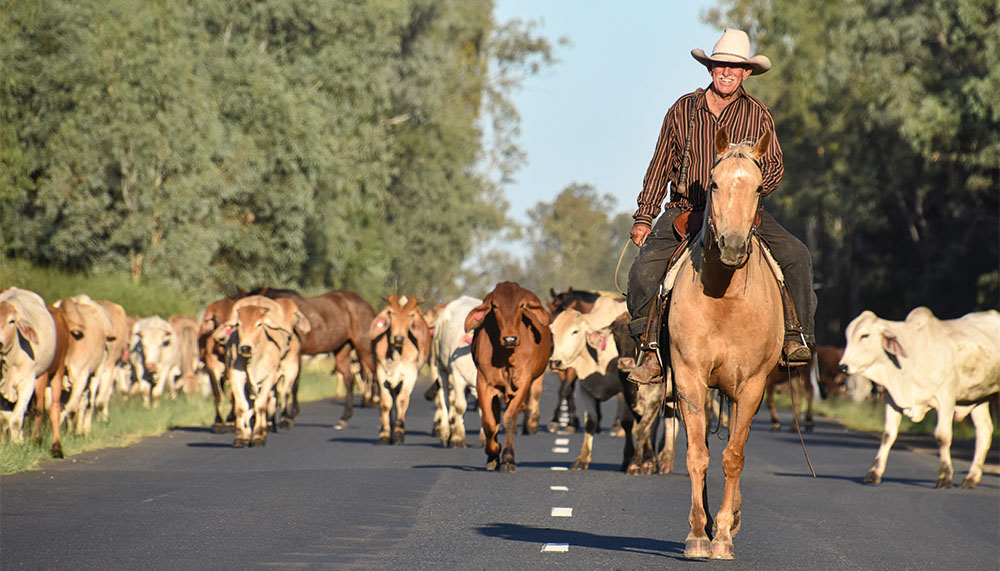Australia’s travelling stock routes remain vital for the movement of livestock and the conservation of our environment.
Story Kerry Sharp Photo Trina Patterson
In the late 1960s, Ian Chisholm was a keen, young bore runner with enormous responsibilities. He worked with specialist government maintenance crews out of Elliott on the Barkly, patrolling isolated NT stock routes to ensure life-saving artesian water was pumped to the surface for thirsty drovers and their travelling cattle mobs.
Ian’s rounds included the Barkly Stock Route between Elliott and Camooweal at the Queensland border, the rarely used South Barkly Stock Route between Brunchilly station and the Ranken River Store, and the infamous ‘Ghost Road of the Drovers’, the Murranji Track between Newcastle Waters and the Victoria River District (VRD). The 660km Barkly had 26 bores, all with Comet windmills attached, sunk 25–30km apart to fit in with a good day’s walk for a mob of cattle.
“We lived out of our work trucks, shared camp fires with drovers we came across, and often did night watches for those who’d had a rough time on the track or who were down on men,” says 82-year-old Ian, now retired in Alice Springs. “We delivered mail to people along the route and could pass on messages, too, because we had radio transmitters. The drovers always made sure we got a good feed, and a big bag full of beef to take home.”
Life on the stock routes mostly flowed smoothly for the Elliott work crews, but sometimes threw up grim reminders of why bore maintenance patrols were so critical. They came across crude wooden crosses marking the lonely graves of unnamed people who’d died along the tracks.
Ian tells of the time he was sent out to fix a faulty pump at Alluvial Bore, 65km west of Tennant Creek, after a fellow bore man assigned to do the job went on a bender and didn’t turn up for work. “We arrived to find more than 20 horses in the immediate vicinity, all dead from a lack of water, and one stallion barely alive. The ground around the bore was littered with dead birds – mostly finches and spinifex pigeons. It was a terrible scene, the only time I ever encountered lots of birds perishing like that.”
In 1963, while assigned to the Murranji, Wave Hill and Dry River stock routes, Ian and fellow crew members Ted Pearce and Laurie Fuchs were dispatched urgently from Elliott to fix a faulty bore at GB Rockhole. “We were told, ‘Don’t stop till you get there’, because two cattle mobs were moving onto that water. Around three in the morning we passed the first mob strung out for a couple of miles. They’d had to bypass the broken bore, which had no water and still had 20 miles [32km] or more to go before they could get a drink at the next bore on Wave Hill. We camped a couple of days out there, filling the tank with a pumpjack we’d brought with us, while waiting for the second mob to water, before we reconnected the bore pump to the windmill. Sadly, on our way home we came across 20 or so of the first mob that hadn’t made it.”
Australia’s pastoral heritage overflows with such remarkable real-life accounts from generations of stock route users – the 1800s pioneering overlanders who forged tracks across the landscape; the robust 1950s drovers, who lived simply and contentedly with what they could carry in their packs; and today’s well-equipped but equally hardworking drovers, who take up contracts to channel much bigger mobs along properly formed stock routes and major rural roads.
Modern-day drovers are accompanied by back-up vehicles, generators, refrigeration, modern communications and electric fences that cancel the need for night watches, as they ride the fabled Long Paddock – the vast labyrinth of stock routes that have crisscrossed Australia since the mid-1800s.
This story excerpt is from Issue #141
Outback Magazine: February/March 2022









